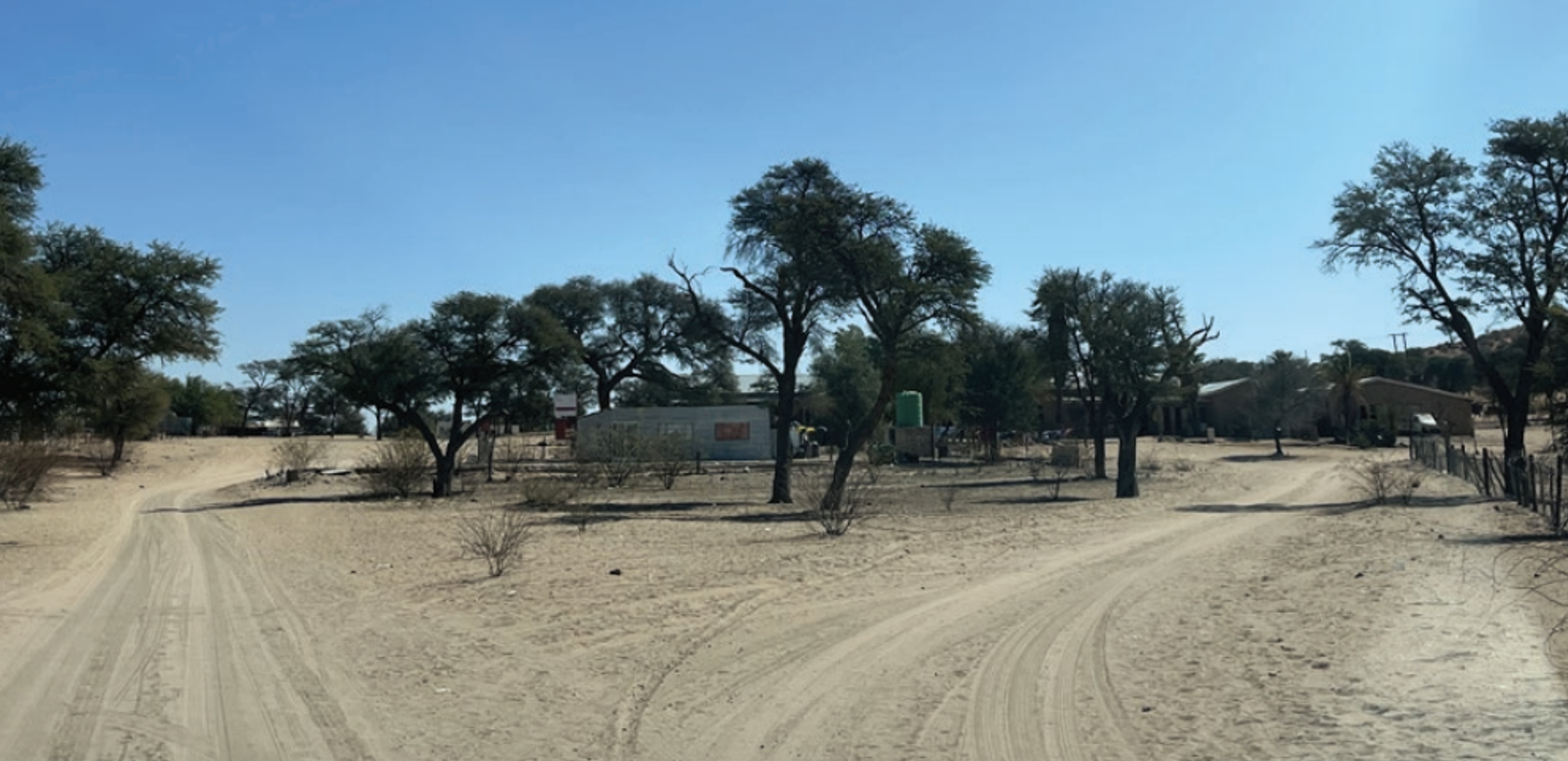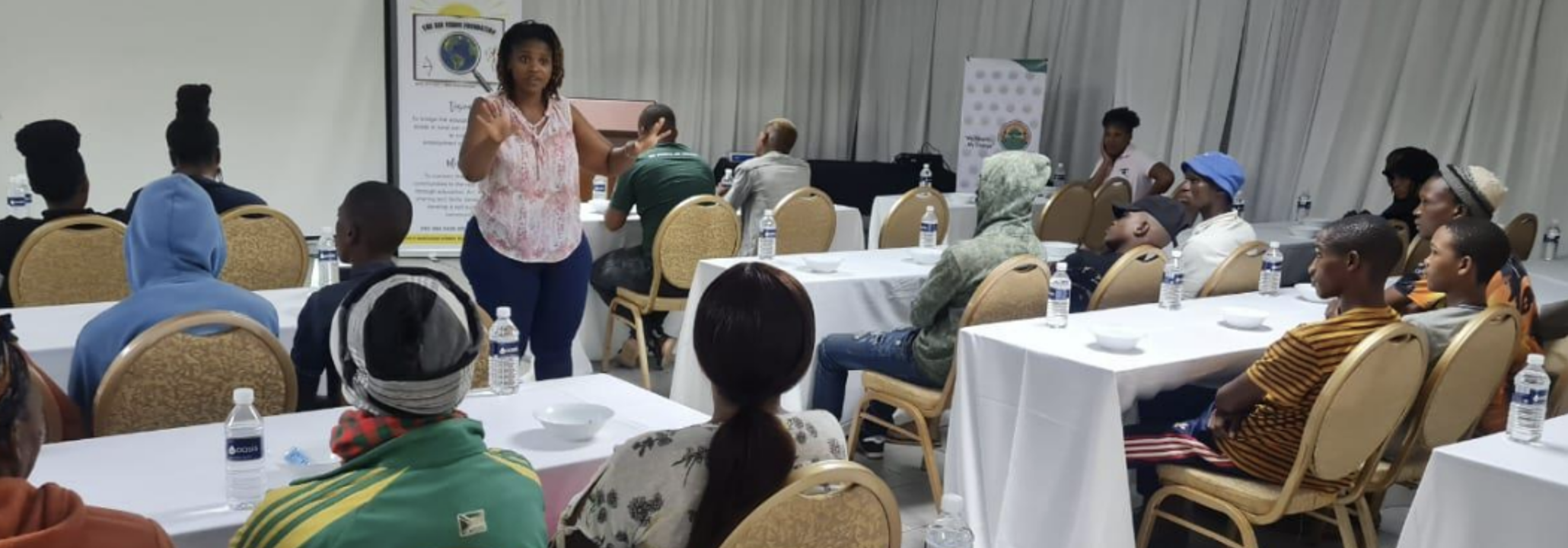South Africa
1. ANDRIESVALE
Background
The majority of ‡Khomani San in this area were forced to give up their hunting & gathering lifestyle, as a result of the creation of the Kgalagadi Transfrontier Park in 1931. A few families were able to stay on in the Park, as labourers and trackers, until they were expelled in the 1970s. As part of a land claim process, the surviving claimants had to provide convincing evidence that they were indeed the aboriginal people of this territory.
The land claim was settled in 1999. Today, this area is called Andriesvale.
The ‡Khomani San have lost their sense of community and identity by being dispossessed of their territories and physically dispersed.
The land that was given to these people doesn’t fall under any municipal jurisdiction, which means the Government does not supply infrastructure. NGOs and other institutions provide some financial support to develop and maintain very basic infrastructure.
Socio-Economic Profile
# of People: 0 – 18 years (310), 18 – 60 (401), 60 years and older (42)
Schools: 1 x ECD centre, 1 x Primary school
Housing: Mostly metal corrugated sheet houses (shacks), with very few brick and mortar buildings
Economy: There is a small shop that supplies basic groceries; bottle Store; tavern
Management: CPA (Community Property Association); acts as a governing body
Roads: Roads are sand roads
Electricity: Very few have a primative solar panel that charge batteries for cellphones, otherwise no electricity
Income: The people that have jobs work at: nearby Molopo Guest Lodge, schools, CPA office, tavern, shop, bottle store or they are entrepreneurs who sell arts & crafts along the road; Government grants
Palms for Life Investment
Since 2023, Palms for Life has made a difference in Andriesvale by:
Equipping 2 x existing boreholes with solar pumps to ensure constant clean water to the community. Prior, one borehole ran with a diesel engine, however, money for diesel was not always available. Now, the pumps work with no cost whenever the sun is shining.
Installing environmentally friendly toilets to households where there were no toilets before (almost all households). At the end of January, 40 toilets will be completed and another 80 will be installed over the next few months.
2. PLATFONTEIN
Background
Platfontein (15 kms outside of Kimberly) is the largest San township in Southern Africa, home to !Xun and Khwe people. The population is growing rapidly, from 5,000 (2011) to current estimates of ~10,000, likely due to the high rate of early teenage pregnancy.
There is a complex history of resettlement for the !Xun and Khwe in Platfontein, who are unrelated, and originally come from Namibia and Angola. They fought, often forcibly, alongside the South African National Defense Force (SADF) during the Namibia War of Independence, forming what was called the ‘Bushman Battalion’. After this, many were relocated to an informal ‘tent-town’ in Schmitsdrift (80 kms west of Kimberly), followed by a 2nd relocation to Platfonetin in ~2003. South African citizenship was granted. There are many, significant negative impacts from these forced relocations and loss of lifestyle/livelihood and mobility.
The !Xun comprise ~60% of Platfontein's San population and primarily speak !Xuntali. The Khwe comprise ~40% of the San population and speak Khwedam. There is growing concern over the diminishing use of the !Xuntali and Khwedam among the younger generations, who often prefer English and Afrikaans. To work effectively here, PFL has had to dedicate significant time to relationship building and understanding the socio-political context.
Socio-Economic Profile
Basic services: 1 x school (Grade R - Matric), a municipal building, health clinic, a community radio station, shared between the !Xun and Khwe communities
Social services/infrastructure: Majority (70%) provided by NGOs, with government contributing only 19%; there is a lack of amenities (running water in homes, proper sanitation, electricity very limited access to internet (ELRU Report, 2022);
Housing: Majority live in low-income, government-built RDP housing (a two-room accommodation).
Income: Over 70% of households rely on domestic grants.
Overall: There is a general feeling of abandonment by the government, presumably due to the historical SADF affiliation during the fight against liberation forces including the South African ruling party, the ANC and SWAPO in Namibia. Alcoholism/drug abuse are prevalent, including during pregnancy. There is high demand for Early Childhood Development (ECD) services/centers, playgrounds, safe spaces, access to healthy food and healthcare and a need for income generating opportunities.
Palms for Life Investment
Since mid-2022, Palms for Life has:
Engaged with the !Xun and Khwe communities and supported local NGOs to build trust and identify pressing issues:
Situational Assessment completed to inform activities
MoA signed with the Northern Cape Department of Education (supporting the launch of a new ECD in Platfontein/expanded ECD projects in the region)
Partnership agreements signed with The San Vision Foundation (TSVF) and The San Community Development (SANCD) to clarify PFL Program intentions and help build capacity
Oral agreement with the Platfontein Community Property Association (CPA), a role-player in the area
Implemented the Pilot Matric 2nd Chance Program to address high school dropout and unemployment; this program experienced significant challenges and generated many lessons learned for future projects.
Launched the ECD Project to design and construct a 160-student ECD Center aimed to improve school readiness and preserve San culture and language, with completion expected late 2024; based on the prior Situational Assessment.
Designed an ECD Teacher/Staff Training Project, in agreement with the Northern Cape Department of Education (targeted launch early 2024)
Launched an Entrepreneurship Training Project with SANCD, to equip 10 youth with introductory business skills to start small-scale enterprises
Engaged INMED to design an aquaponics project to support skills development, income generation and accessibility of nutritious food.
3. RICHTERSVELD
Background
The Richtersveld is embodied in the richness and ethos of the indigenous communities, predominantly the Nama people, who call this land home. The Richtersveld is a rugged, arid, desert landscape and consists of the six towns of: Port Nolloth, Alexander Bay, Koeboes, Sanddrift, Lekkersing and Eksteenfontein, with over 5,600 households. The Nama people, originating in southern Namibia and northern South Africa, regained title and community ownership of their ancestral lands in 2002, and 80% of the Richtersveld population is of Nama descent. Decent numbers of the older generation speak the Nama language, but few youth and young children can speak Nama. The language, and Nama culture, are not taught in schools which must be corrected if we want to preserve the language and the Nama culture.
Socio-Economic Profile
The Richtersveld towns are poorly resourced, and development in the area is constrained, with high poverty. Communities are located in highly isolated areas that do not offer job opportunities or adequate infrastructure, like schools and healthcare facilities. There is high youth unemployment, a prevalence of gender-based violence, and high alcohol and substance abuse.
Matric completed: ~24%
Unemployment: ~42% youth (more details in the recent ELRU report, completed in Nov 2023)
Palms for Life Investment
Since 2023, Palms for Life has:
Facilitated an in-depth Situational Analysis (ELRU), to gain an understanding of basic needs, the ECD landscape, and issues around cultural preservation to inform highest impact activities. This included the short-term hire of local community members from all six towns to assist.
Held introductory meetings with the local municipality, community members and the San Council to understand the local context and potential partnerships
Applied for nonprofit certification for Purukutsi Foundation; certificate was received; this is for the ǂKhomani San community.
Applied for land to build ECD Centre for the Purukutsi Foundation where language and culture will be part of the curriculum; application pending. N|uu language (see also Palms for Life language preservation project)
4. LANGUAGE PRESERVATION WORK: N|uu LANGUAGE PRESERVATION PROJECT
Background
This activity is Palms for Life’s contribution to the International Decade of Indigenous Languages (IDIL). In partnership with a qualified South African linguist and ULIZA, a company that produces a special language app with the use of AI, this Project is creating publicly accessible digital resources in N|uu language, translated into English and Afrikaans, based on the ǂKhomani San | Hugh Brody Collection at the University of Cape Town.
This Project is based on 20 years of verbatim audio and video content in the language spoken (N|uu, Nama, Kora and Afrikaans), as spoken by the ǂKhomani people. By transcribing and translating the files, the content becomes accessible to a much wider audience, and the files will be searchable and available in suitable formats for future research and language preservation.
The methods include verifying existing audio/video content of over 330 files, conducting multi-lingual transcripts and translations, with verifications, creating bilingual subtitles, adding tagwords for searches, and ensuring the collection of files is publicly accessible and searchable in the University’s Ibali archives.
There is currently only 1 remaining fluent speaker of N|uu, and she is 90 years old (Ouma Katrina); in the 1990s, there were 26 fluent speakers. Based on a Cultural Heritage Audit in the Kalahari Region of South Africa, (1997-2011), ǂKhomani descendants declared that they still speak their language- that it is an integral part of their culture and history- and that they want their language documented and preserved for future generations.
This is a time-urgent Project, which is part of an ongoing effort to document and preserve San languages.
Future Investments with Language Preservation
Custom-design projects, and generate footage and audio recordings, for additional language presevation:
Platfontein: !Xun and Khwe
Riemvasmaak: Nama
Richtersveld: Nama
Kalahari: Nama
Douglas: Griekwa
*Dots and circles indicate geographic areas for language preservation with this Project.


